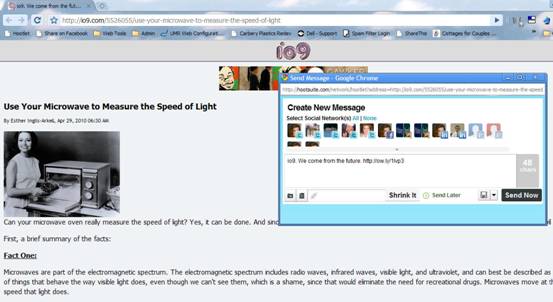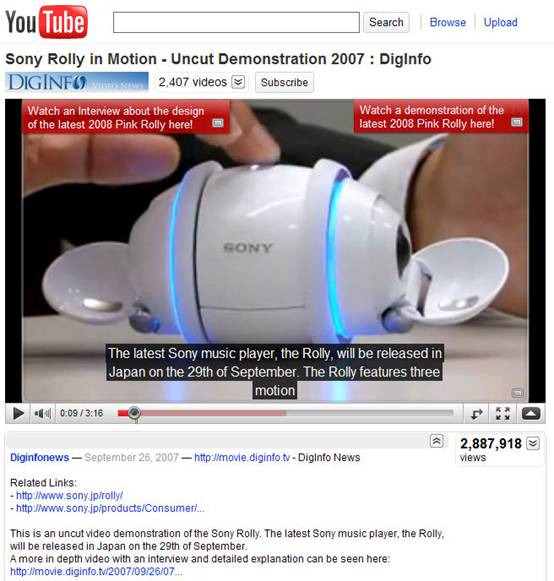Social Networking and Bookmarking sites have become a great way to boost the profile of your website across the internet and automated sharing and posting tools have made it so easy to share links, but don’t forget that your site is the foundation of your Social Media activities and you must ensure that it’s set up to feed the information in the most useful way.
Most website owners know that meta tags have an impact on search engine results. Those more experienced in search engine optimization (SEO) know that Title and Description meta tags have great impact in getting good results through search engines, but it seems many have overlooked how Titles and Descriptions are important for Social Media Optimization as well.
Here’s an example of posting a link from the Sports Illustrated channel of the CNN site onto Twitter, using Hootsuite’s Hootlet link sharing tool:

You can see in the source code where relevant content is used in the Title and Description meta tags:

One of the most important features of social media sites is the ability to post your own links to your account, and an even bigger benefit is that visitors to your site can post links to your site to their own networks to share with their connections. That’s why we add Share It buttons and other ways to easily post links to our sites on the most popular social media networks.
Most social networking sites, and sharing tools that feed into them, use the Title tag as the title of the post on the site and the Description meta tag to provide a description. You can influence how the post to your link appears on the social networking sites by making sure that your Titles and Descriptions are properly populated on your site.
If you don’t use some sort of Content Management System (CMS) to generate your site, then you have complete control over these tags and can enter the best content here for Social Media posts, as well as SEO. Just ensure that you know how to do this with whatever application you use to code your pages. Most WYSIWYG editors have an area where you can edit the meta data for your page. If you are not setting up or updating your own site, it’s very important that the web developer you hire is aware of the importance of Titles and Descriptions, and uses best practices for SEO and Social Media as standard.
If you do use a CMS; whether a blogging application like WordPress, a portal application like Joomla, a shopping cart like Magento, or a bespoke CMS of a web development company; you should ensure that these tags are populated in a way to get the most benefit for your site:
- It’s best if you have complete control to add unique content for the Title and Description tags on each page generated. If your CMS does not come with this feature you may be able to install a plug-in or add-on to allow this. For example, there is a number of SEO plug-ins for WordPress that have this feature.
- It may work fine for you if the Title and Description are automatically populated from a set area of your page in the CMS. Many CMS applications will use the Title of a page/post as the Title tag and use content from the text page/post or an excerpt field to populate the Description meta tag. If you have a site with many dynamically created pages (i.e. a Shopping Cart or large directory) it is important that this content is populated automatically in an effective way.
- It’s completely useless if you are only allowed to enter one Title and Description that’s used on all the pages of the site – or not allowed to specify these tags at all. It would be pretty much impossible to create a single Title and Description that would be relevant for every page of your site. (You do know this is a killer for SEO as well, right?) As noted above, you should look for a plug-in or add-on for your CMS so that you can have unique Title and Description tags – or get a new CMS!
Here’s another example of posting a link to a site using Hootlet:

The content automatically generated for the post is generic for the entire site and not relevant to this specific page, as you can see from the source code:
![]()
…and OOPS! There’s NO Description meta tag!
The use of Titles and Descriptions is also relevant to posting on Social Bookmarking Sites.
Here’s an example of a page from Wired that’s bookmarked on DIGG:

The link posted on Digg:

The code showing the Title:
![]()
…and the Description (where you can also see that Wired is using the All-in-1 SEO Pack for WordPress):

You can see that the person that posted the link to Digg kept most of the automatically generated content, but edited the title and added some ‘editorial’ at the front of the description, as many people will do, but kept most of what was generated.
It is true that in many cases users can write their own content when posting your link, but if the information automatically given provides accurate descriptive information they may just post with your chosen information or write their own comment along the same lines.
If there is no information automatically generated, or if it is irrelevant, the person may choose to not post your link at all rather than create their own text. Remember that the user is posting this content to his own account and so wants to include the most helpful, relevant information for his connections. The easier you make it, the more likely for users to post and share your link.
Along the same lines, it’s important to make sure that pages with multimedia content (images, videos and sound files) have relevant Title and Description tags.
Here’s an example of posting a link to a page with a podcast from Oprah.com onto a Facebook wall:

The user must add descriptive text on Facebook because the automatically generated content is not specific to the podcast:

Anyone else sharing the post from here will also need to add descriptive text as text the first user added doesn’t automatically get posted when shared.
You can see in the code for the Oprah.com page, the Title and Description meta tags are not specific to the podcast on the page:

Of course, YouTube provides a good example – here’s a YouTube video posted on Facebook:

Here’s the YouTube page:

…and you can see in the source code where the Title and Description are relevant to the specific video:


Looking at this source code I see that the Title on Facebook is actually taken from the meta tag Title (if included) and not from the actual Title tag itself (which begins “YouTube”).
So, if it wasn’t clear enough to website owners and developers that Titles and Descriptions are important for SEO; the relevance of these tags in Social Media is now even more ‘in your face’, so hopefully won’t be dismissed.
Funny enough, Facebook’s own pages don’t seem to have good Title and Descriptions. The link posted here was to the webpage on Facebook Pages:


(Facebook does provide information for developers on ways to ensure content is posted with accurate information: http://developers.facebook.com/docs/opengraph and http://wiki.developers.facebook.com/index.php/Facebook_Share/Specifying_Meta_Tags.)
Yet again, it turns out that getting back to basics and providing relevant Title and Description meta tags for each page of your website is best practice. Up until now we knew this was important to provide useful information to visitors and search engines, but now it’s important to get best exposure on Social Networking sites.



